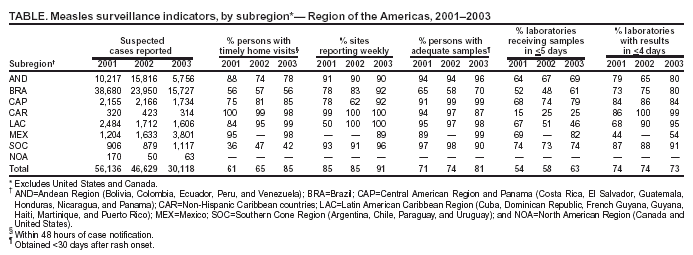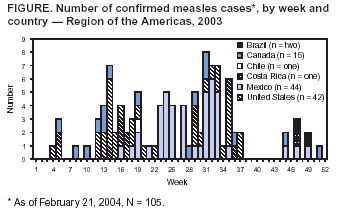 |
|
|
|
|
|
|
| ||||||||||
|
|
|
|
|
|
|
||||
| ||||||||||
|
|
|
|
|
Persons using assistive technology might not be able to fully access information in this file. For assistance, please send e-mail to: mmwrq@cdc.gov. Type 508 Accommodation and the title of the report in the subject line of e-mail. Progress Toward Measles Elimination --- Region of the Americas, 2002--2003In 1994, countries in the Region of the Americas adopted the goal of eliminating endemic measles transmission* in the Western hemisphere by 2000 (2). Since 1994, rapid progress has been made. The number of measles cases has declined >99%, from approximately 250,000 in 1990 to 105 confirmed cases† reported in six countries in 2003. During 2003, only Mexico and the United States reported outbreaks. The three chains of transmission in Mexico and two U.S. outbreaks were import-related (3); a third U.S. outbreak was of unknown source. Since November 2002, no transmission of the D6 and D9 genotypes has been reported; these genotypes were responsible for several large outbreaks in the region during 1997--2002 (4). This report summarizes the epidemiology of measles in the Americas during 2002--2003 and highlights progress toward measles elimination, including the lowest ever number of reported measles cases in the region. Because the region is under constant threat of measles importation from regions where the disease is endemic, countries must maintain high population immunity to measles and sensitive surveillance to ensure the timely detection of imported cases and allow for rapid implementation of control measures. Vaccination ActivitiesKey vaccination activities in the measles-elimination initiative include implementing the Pan American Health Organization (PAHO)'s recommended vaccination strategies§ or attaining >95% routine vaccination coverage with 2 doses of measles-containing vaccine (MCV) (5). Special efforts in the region have focused on identifying and increasing vaccination levels in districts at high risk because of high population density, high rural-to-urban migration, presence of indigenous populations and tourism, populous border regions, areas with low vaccination coverage, and areas with poor surveillance or poor access to health services. The most important of these activities were nationwide supplemental immunization activities (SIAs); 10 of these were conducted in 2002. The estimated number of children vaccinated against measles in SIAs was 10.4 million in 2000; 10.6 million in 2001; and 9.9 million in 2002. Reported routine measles vaccination coverage for the region¶ was 94% in 2000, 96% in 2001, and 92% in 2002. In 2002, reported routine coverage ranged from 51% in the Latin American/Caribbean subregion to 99% in the Southern Cone subregion (i.e., Argentina, Chile, Paraguay, and Uruguay). Coverage of >90% was reported by 28 countries; 12 reported coverage of <90%. The percentage of children living in municipalities with routine coverage of >95% was 55% in 2000, 59% in 2001, and 50% in 2002**. Measles SurveillanceDuring 2002--2003, the number of suspected measles and rubella cases (defined as a febrile rash illness or any case for which a health-care provider suspects measles or rubella) notified to national surveillance systems decreased from 46,629 to 30,118 (Table). The proportion of suspected cases with a timely home visit for case investigation increased from 65% in 2002 to 85% in 2003. During 2002--2003, the proportion of persons with suspected measles with adequate specimens taken for laboratory diagnosis increased from 74% to 81%, and the proportion of notification sites sending weekly reports increased from 85% to 91%. The rate of notification of febrile rash illnesses that are not measles, rubella, or dengue declined from 6.7 per 100,000 population in 2001, to 6.2 in 2002, and to 4.6 in 2003. Measles Epidemiology, 2002--2003In 2002, a total of 2,584 confirmed†† measles cases were reported in the Americas. Of these, 2,397 occurred during an outbreak in Venezuela after an importation of a D9 measles virus from Europe (6,7). The outbreak affected 16 (67%) of the 24 states in Venezuela. The age groups most affected were children aged <1 year (120 cases per 100,000 population). This outbreak spread to Colombia, where 139 cases were reported. The last confirmed measles case in these outbreaks, and the last case attributed to the D9 virus in the Americas, occurred in Venezuela in November 2002. In 2002, an additional 44 confirmed cases were reported in the United States, six were reported in Canada, and one was reported in Brazil. In 2003, a total of 105 confirmed measles cases were reported in the Americas, the lowest number ever reported in the region. Of these, one occurred in Chile, one in Costa Rica, two in Brazil, 15 in Canada, 42 in the United States, and 44 in Mexico (Figure). The case in Chile occurred in a man aged 33 years who had rash onset on March 28 after travel to Japan. The case in Costa Rica occurred in a man aged 38 years who had rash onset on November 17 after returning from travel to India. In Brazil, the first case occurred in a man aged 34 years who had rash onset on November 21 after travel to Germany, England, and Holland. The second case occurred in a child aged 11 months of the initial patient, with symptom onset on December 1. The 15 cases in Canada were all imported§§. Of 42 U.S. cases, 33 were imported or linked to an importation; the remaining nine cases were of unknown origin¶¶. During 2003, Mexico reported three chains of transmission, with a total of 44 confirmed measles cases occurring in 17 municipalities. In 41 cases, rash onset occurred during April 13--August 25. Subsequently, three cases were detected with rash onset in November and early December. Of the 44 confirmed cases, 14 occurred in infants aged <1 year and 12 in adults aged 20--29 years; 42 patients were unvaccinated. The first chain of 22 cases had rash onset during April 13--July 4, the second chain of 19 cases had rash onset during July 22--August 25, and the last chain of three cases had rash onset in November and early December. To control the outbreaks, Mexican authorities conducted clinical and epidemiologic case studies and active case searches around homes of confirmed patients and in areas at high risk. Approximately 10 million children aged 6--11 years were vaccinated as well as groups at high risk (e.g., health-care workers). During 2003, two measles-related deaths occurred in the United States. One death occurred in an immunosuppressed male aged 13 years who had neurologic complications and had measles virus isolated from a brain biopsy. The other fatal case occurred in a man aged 75 years who, within 2 weeks of his arrival from overseas, had a rash illness and subsequently died of pulmonary and neurologic complications. Serologic tests were positive for measles IgM. Virologic SurveillanceThe H1 virus genotype, known to circulate in parts of Eastern Asia, was identified from three separate chains of transmission in Mexico and from one chain of transmission in Hawaii that were either imported from the Marshall Islands (H1) or of unknown source. This genotype also was found in Chile's imported measles case. The D9 virus, imported from Europe, circulated for 16 months in Venezuela and Colombia during 2001 through November 2002. In addition to the Hawaiian cases, outbreaks and cases reported in the United States during 2003 for which viral genotype information was available were associated with travel from Lebanon (D4) (3), Germany (D7), France or Italy (D7), and Israel (D6). Reported by: Ministries of health or public health authorities in the countries of the Region of the Americas. J Andrus, G Tambini, K Kohler, A Ropero, C Castillo, M Landaverde, J Fitzimmons, S Garcia, Family and Community Health Area, Pan American Health Organization, District of Columbia. J Rota, P Rota, W Bellini, Div of Viral and Rickettsial Diseases, National Center for Infectious Diseases; F Lievano, C Lee, V Dietz, Global Immunization Div, National Immunization Program, CDC. Editorial Note:During 2003, the countries in the Western Hemisphere reported the lowest number of measles cases ever and two measles-related deaths. The goal of measles elimination in the region might have been achieved. Ongoing epidemiologic and virologic surveillance will be required to confirm the absence of endemic strains of measles virus. The substantial reduction in transmission of measles in the Americas underscores the need for criteria to define and certify when elimination has been achieved. The outbreaks in Mexico during 2003 also highlight the need for criteria for determining when any importation-related chain(s) of transmission suggests reestablishment of endemic transmission. Despite these successes, several trends in the region are of concern. First, measles vaccination coverage indicates a slightly decreasing trend, which has been attributed to improvements in calculating population-based coverage (PAHO, unpublished data, 2004). Second, the number of reported suspected cases and the rate of notification of suspected cases have decreased. The cause of these decreases is unknown but could be explained in part by long-term cyclical trends in the circulation of other viruses that produce febrile rash illnesses. PAHO is evaluating the surveillance data to identify a specific indicator for monitoring sensitivity of surveillance. The measles-associated deaths that occurred in the United States underscore the risks associated with importation of measles. One case might have been an importation from overseas; the other is of unknown origin, although the virologic genotype isolated matched a Philippines genotype. Because the region is under constant threat of measles importation from regions where the disease is endemic, countries must maintain sensitive surveillance to ensure the timely detection of imported cases and allow for rapid implementation of control measures. Continuous training of health professionals is necessary to maintain this high quality of surveillance. Vaccination activities must continue to ensure the highest possible population immunity (i.e., >95%), and timely follow-up campaigns are necessary to reduce the number of susceptible persons. Active case-finding should continue, and countries should identify and prioritize high-risk areas. Success with measles elimination and the development of a strong surveillance and laboratory network in the region provide the foundation for additional accelerated disease-control activities. In September 2003, PAHO passed a resolution to eliminate rubella and congenital rubella syndrome from the region by 2010 (8). To meet this goal, countries are drafting national plans of action. The integration of measles and rubella surveillance and combined measles-rubella vaccines will facilitate this endeavor. References
* Measles elimination refers to interruption of endemic transmission in a sizable geographic area in which vaccination must continue because of the continued threat of reintroduction of the virus (1). † Provisional data as of week 7 (week ending February 21, 2004). § The PAHO-recommended measles vaccination strategy has three key components: 1) a one-time national "catch-up" campaign for all children aged 1--14 years, 2) routine "keep-up" vaccination for infants aged 1 year, and 3) national "follow-up" campaigns every 3--5 years for all children aged 1--4 years, regardless of measles vaccination history. ¶ Excluding the United States and Canada. ** This information is not collected in the United States or Canada. †† Include clinically confirmed cases, laboratory-confirmed cases, and suspected cases linked epidemiologically to a laboratory-confirmed measles case. §§ Cases among persons who were infected outside Canada. ¶¶ Includes all other cases acquired in the United States for which no epidemiologic link or virologic evidence is found to indicate importation.
Table  Return to top. Figure  Return to top.
Disclaimer All MMWR HTML versions of articles are electronic conversions from ASCII text into HTML. This conversion may have resulted in character translation or format errors in the HTML version. Users should not rely on this HTML document, but are referred to the electronic PDF version and/or the original MMWR paper copy for the official text, figures, and tables. An original paper copy of this issue can be obtained from the Superintendent of Documents, U.S. Government Printing Office (GPO), Washington, DC 20402-9371; telephone: (202) 512-1800. Contact GPO for current prices. **Questions or messages regarding errors in formatting should be addressed to mmwrq@cdc.gov.Page converted: 4/15/2004 |
|||||||||
This page last reviewed 4/15/2004
|